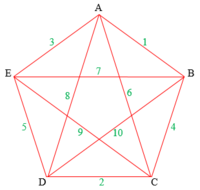Beingmayaj
New member
- Joined
- Jan 16, 2020
- Messages
- 1
Hello!
So I have no idea what type of equation this would be to figure out but I really need some help!
We have 5 people. These 5 people need to be split into groups of two over the course of 52 weeks to work in pairs on the Sunday of every week. Since the number is odd, the groups aren’t going to be the same every week of course and we also want everyone to work an equal amount of days without anyone having to work two weeks in a row. How do you split up everyone over 52 weeks to where each person is working the same amount as the other without having someone work two weeks in a row? Or can someone tell me if it only works out to where someone would have to work two weeks in a row? I really hope that makes sense.
Thank you to anyone that can help.
Here is an example of a pattern I started in my head where everyone is labeled as a number and grouped but I don’t think it works:
12
34
51
24
35
12
34
51
24
35
51
23
So I have no idea what type of equation this would be to figure out but I really need some help!
We have 5 people. These 5 people need to be split into groups of two over the course of 52 weeks to work in pairs on the Sunday of every week. Since the number is odd, the groups aren’t going to be the same every week of course and we also want everyone to work an equal amount of days without anyone having to work two weeks in a row. How do you split up everyone over 52 weeks to where each person is working the same amount as the other without having someone work two weeks in a row? Or can someone tell me if it only works out to where someone would have to work two weeks in a row? I really hope that makes sense.
Thank you to anyone that can help.
Here is an example of a pattern I started in my head where everyone is labeled as a number and grouped but I don’t think it works:
12
34
51
24
35
12
34
51
24
35
51
23

